Material Properties: The Foundation of Durability
The inherent properties of aluminium and wood create fundamental differences in how sliding doors perform over time. Understanding these material characteristics helps explain why durability varies significantly between these options.
Aluminium Frame Properties
Aluminium sliding door frames offer exceptional strength-to-weight ratio, making them simultaneously robust and lightweight. This metal naturally forms a protective oxide layer when exposed to air, providing inherent resistance to corrosion. Modern aluminium doors utilize alloys specifically engineered for building applications, further enhancing their durability credentials.
The non-porous nature of aluminium means it doesn’t absorb moisture, preventing the swelling, warping, and rotting issues that plague organic materials. This stability remains consistent regardless of humidity fluctuations—a significant advantage in coastal Australian regions.
Wooden Frame Properties
Wooden sliding doors possess natural insulative properties and aesthetic warmth that many homeowners appreciate. However, wood’s organic composition makes it inherently vulnerable to environmental factors. Even treated timber remains susceptible to moisture absorption, which can lead to dimensional changes over time.
Different wood species offer varying levels of natural durability. Hardwoods like spotted gum or ironbark provide better resistance than softer varieties, but all wooden doors require protective finishes to maintain their integrity. These protective barriers require regular renewal to remain effective.
Structural Integrity Comparison
When comparing structural integrity over decades of use, several factors differentiate these materials:
- Aluminium maintains consistent dimensions regardless of temperature and humidity fluctuations
- Wood expands and contracts with seasonal changes, potentially affecting operation
- Aluminium frames resist twisting and warping even with large glass panels
- Wooden frames may require thicker profiles to support the same glass weight
- Aluminium’s uniform composition ensures consistent performance throughout the frame
“The structural stability of your sliding door frame directly impacts long-term operation. While wooden doors may offer traditional appeal, their tendency to expand, contract, and potentially warp creates alignment issues that affect smooth sliding action over time.”
Climate Resistance: Performance in Australian Conditions
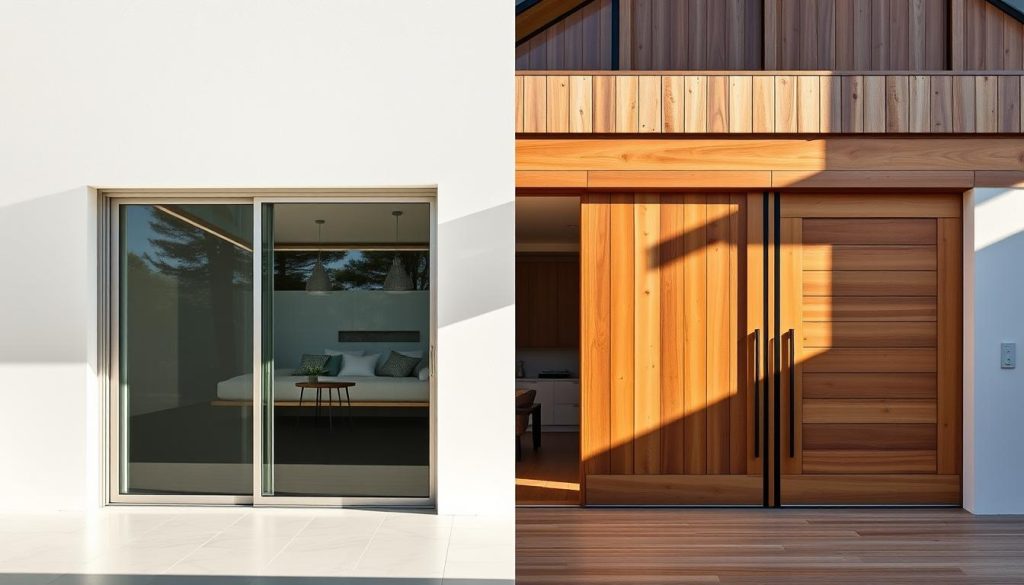
Australia’s diverse climate presents unique challenges for building materials. From the tropical humidity of Queensland to the intense UV exposure across the continent and the salt-laden air of coastal regions, environmental factors significantly impact sliding door durability.
UV Resistance
Australia receives some of the world’s highest UV radiation levels, which degrades many building materials over time. Aluminium sliding doors maintain their structural integrity under intense sunlight, with only the powder coating potentially fading after many years of exposure—an issue easily addressed through recoating.
Wooden sliding doors suffer more significant UV damage, with untreated surfaces degrading within months. Even with protective finishes, wooden doors require regular refinishing to prevent the UV breakdown of lignin, which causes greying, cracking, and eventual structural compromise.
Moisture Resistance
In humid coastal environments and regions with high rainfall, moisture resistance becomes crucial for sliding door durability. Aluminium frames remain dimensionally stable regardless of moisture exposure, with properly designed drainage systems channeling water away from vulnerable components.
Wooden sliding doors, even with protective treatments, remain vulnerable to moisture infiltration at joints and end grain. Over time, this can lead to swelling, warping, and eventual rot—particularly in high-humidity environments where drying periods are limited.
Coastal Performance
Salt-laden air in coastal regions presents perhaps the most aggressive environmental challenge. Quality aluminium sliding doors utilize marine-grade alloys and finishes specifically designed to withstand these conditions. With proper maintenance, they can maintain their integrity for decades even in beachfront locations.
Wooden sliding doors in coastal environments require exceptional vigilance. Salt accelerates moisture-related deterioration, and even premium hardwoods struggle to maintain their integrity without frequent maintenance. This vulnerability often results in operational issues and shortened lifespan.
Temperature Fluctuation Response
Beyond moisture and UV exposure, how sliding doors respond to temperature changes affects their long-term durability:
- Aluminium expands and contracts minimally with temperature changes
- Modern aluminium systems incorporate thermal breaks to manage temperature transfer
- Wood expands and contracts more significantly with temperature fluctuations
- Repeated expansion/contraction cycles can loosen joints in wooden doors
Looking for Climate-Resilient Door Solutions?
Discover how energy-efficient aluminium sliding doors can protect your home while reducing utility costs.
Maintenance Requirements: The Hidden Durability Factor
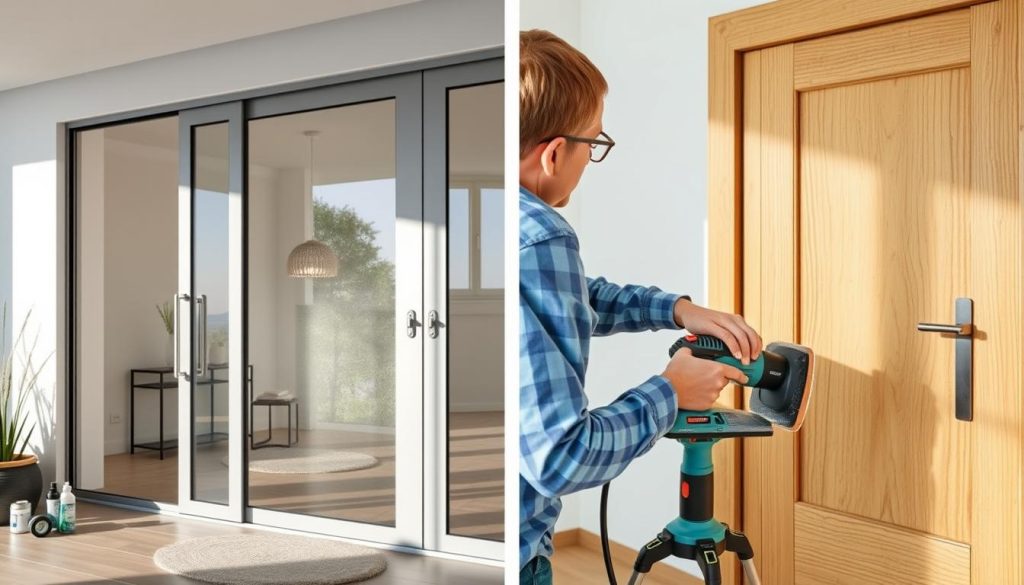
Maintenance requirements significantly impact the practical durability of sliding doors. The time, effort, and cost associated with keeping doors in optimal condition often determine whether homeowners follow through with necessary upkeep, directly affecting longevity.
Aluminium Sliding Door Maintenance
- Simple cleaning with mild soap and water every 3-6 months
- Occasional track cleaning and lubrication to ensure smooth operation
- Hardware inspection and tightening approximately once yearly
- Powder coating touch-up only if damaged (typically not needed for 15+ years)
- No treatment required for moisture or pest resistance
- Maintenance costs remain minimal throughout the door’s lifespan
- Professional maintenance rarely required under normal conditions
Wooden Sliding Door Maintenance
- Regular cleaning plus inspection for moisture damage and pests
- Resealing/refinishing every 2-3 years in moderate climates
- Annual resealing/refinishing in harsh coastal or tropical environments
- Periodic sanding required before refinishing to ensure proper adhesion
- Hardware may require more frequent adjustment due to frame movement
- Significant ongoing maintenance costs for materials and potentially labor
- Professional refinishing often necessary for optimal results
The Maintenance Reality
The theoretical durability of wooden sliding doors assumes perfect maintenance adherence. In reality, many homeowners struggle to maintain the rigorous schedule required, particularly for doors in challenging environments. This maintenance gap often results in accelerated deterioration and premature replacement needs.
Aluminium sliding doors, by contrast, maintain their structural integrity even when maintenance is less than ideal. This forgiving nature makes them particularly suitable for rental properties, vacation homes, or residences owned by time-constrained individuals.
“The most durable door on paper becomes the least durable in practice when maintenance requirements exceed what homeowners can realistically provide. This practical durability consideration often favors aluminium systems, especially in demanding Australian environments.”
Operational Durability: Smooth Function Over Time
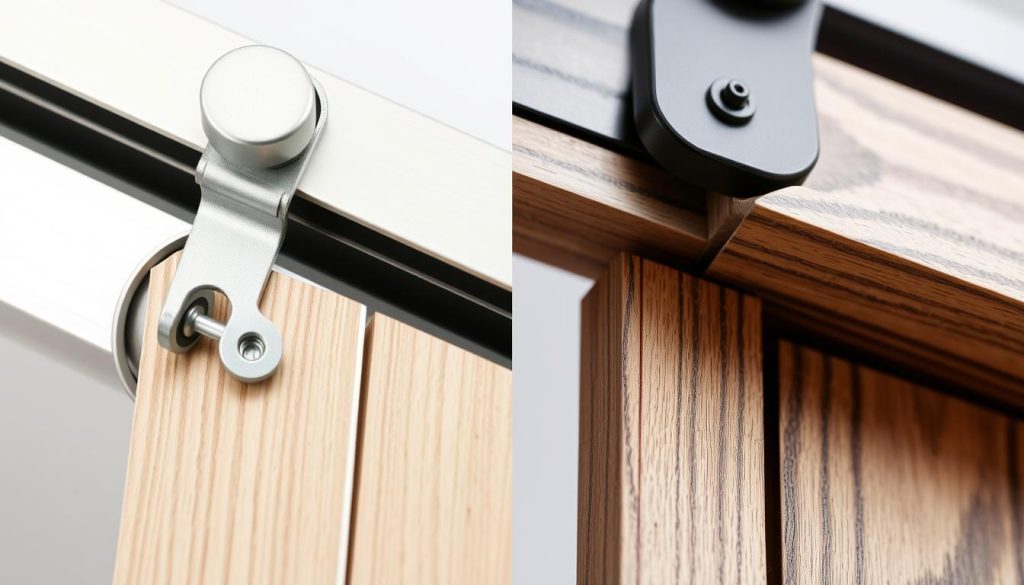
A sliding door’s durability isn’t measured solely by its appearance—smooth, reliable operation over decades represents equally important performance criteria. The operational components and how they interact with the frame material significantly impact long-term functionality.
Track and Roller Systems
Aluminium sliding door frames provide exceptionally stable mounting surfaces for track systems. This stability ensures rollers remain properly aligned even after years of use. Modern aluminium systems feature stainless steel or engineered polymer tracks that resist corrosion and wear, maintaining smooth operation with minimal adjustment requirements.
Wooden sliding door frames present greater challenges for track mounting. As wood responds to environmental conditions, tracks may shift slightly, affecting roller alignment. This movement often creates increasing resistance over time, requiring more frequent adjustment and potentially earlier component replacement.
Weight Management
The weight of large glass panels places significant stress on sliding door frames and hardware. Aluminium’s exceptional strength-to-weight ratio allows for slimmer profiles while maintaining structural integrity. This efficiency enables larger glass panels without compromising operational durability.
Wooden sliding doors typically require thicker frames to support equivalent glass weights, resulting in bulkier profiles. Despite these larger dimensions, wood remains more susceptible to operational issues as environmental factors affect frame dimensions and alignment over time.
Hardware Integration
The interface between hardware components and the door frame material significantly impacts operational longevity:
- Hardware mounted to aluminium frames maintains consistent positioning
- Screws and fasteners in aluminium frames remain securely anchored
- Hardware mounted to wooden frames may loosen as wood expands and contracts
- Fasteners in wooden frames can lose holding power as wood fibers compress
- Locking mechanisms require precise alignment for security and operation
Operational Insight: When evaluating sliding door durability, consider not just the door’s appearance but how smoothly it will operate after 5, 10, or 20 years of use. This functional durability often favors aluminium systems, which maintain their operational precision with minimal adjustment requirements.
Ventilation Integration: Durability with Functionality
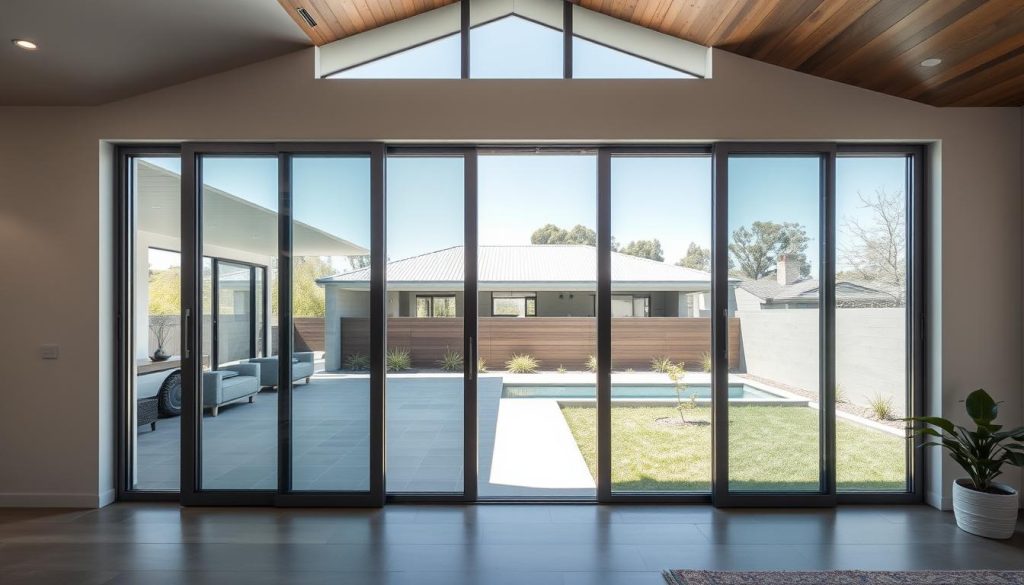
Modern sliding doors often integrate with complementary ventilation systems to enhance functionality. The durability of these integrated solutions varies significantly between aluminium and wooden systems, particularly when considering long-term performance.
Louvre Integration Benefits
Combining sliding doors with stylish ventilation solutions like louvre windows creates versatile systems that maximize airflow control. These integrated approaches offer several advantages:
Aluminium Integration Durability
Aluminium sliding doors integrate seamlessly with aluminium louvre window designs, creating cohesive systems with matching durability profiles. The dimensional stability of aluminium ensures operating mechanisms remain properly aligned even after years of use.
The corrosion resistance of aluminium makes it particularly suitable for ventilation components that experience frequent exposure to outdoor elements. This resistance maintains both functionality and appearance without requiring protective refinishing.
Wooden Integration Challenges
Wooden sliding doors paired with wooden ventilation components face compound durability challenges. Each operable element introduces additional vulnerability points where moisture can penetrate and damage can begin.
The different expansion rates of various wooden components can create alignment issues in integrated systems. These misalignments often worsen over time, affecting both operation and weather sealing—particularly in complex installations combining multiple ventilation elements.
Weather Resistance During Ventilation
Effective ventilation systems must maintain their integrity even when partially open. This capability depends largely on material durability:
- Aluminium components maintain precise alignment for controlled airflow
- Aluminium louvres resist warping even when exposed to rain while partially open
- Wooden ventilation elements may swell when exposed to moisture during use
- Wooden systems typically require more conservative use during inclement weather
Enhance Your Home’s Ventilation
Discover how integrated aluminium sliding door and louvre systems can improve comfort while maintaining durability.
Long-Term Value: The Economics of Durability
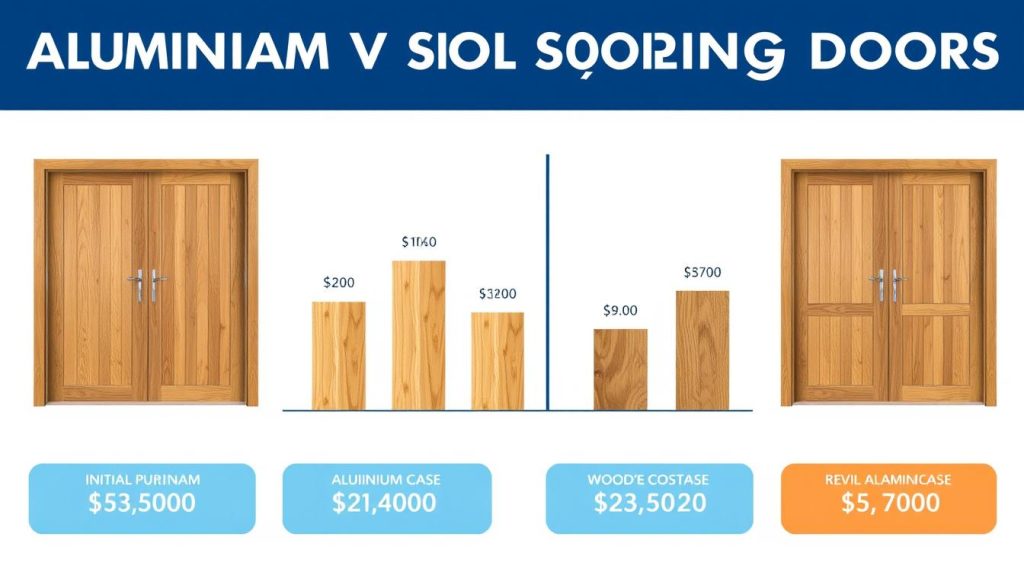
When evaluating sliding door durability, the economic implications extend far beyond initial purchase price. The true cost of ownership encompasses maintenance expenses, energy performance, and expected service life before replacement becomes necessary.
Initial Investment
Quality aluminium sliding doors typically require a moderate initial investment. While not the least expensive option available, they offer excellent value considering their durability profile. Modern manufacturing efficiencies have made aluminium increasingly competitive with premium wooden alternatives.
Wooden sliding doors vary significantly in price based on timber species and quality. Premium hardwood doors often command higher prices than aluminium equivalents, while budget wooden options may cost less initially but generally offer reduced durability and higher lifetime costs.
Maintenance Economics
The maintenance cost disparity between these materials grows substantially over time. Aluminium sliding doors require minimal maintenance expenditure—typically just basic cleaning supplies and occasional lubricant for hardware components.
Wooden sliding doors generate ongoing costs for sanding materials, stains, sealants, and potentially professional refinishing services. These expenses compound over decades, often exceeding the initial price difference between materials within the first 5-10 years of ownership.
Replacement Timelines
Quality aluminium sliding doors in Australian homes regularly achieve service lives of 30+ years with minimal performance degradation. This longevity significantly impacts lifetime value calculations, as replacement costs are deferred for decades.
Wooden sliding doors in demanding environments may require replacement within 10-15 years if maintenance has been inconsistent. Even with diligent care, most wooden doors reach the end of their practical service life within 15-25 years in challenging Australian conditions.
Energy Performance Economics
The energy efficiency of sliding doors affects ongoing operational costs throughout their lifespan:
- Modern aluminium sliding doors with thermal breaks offer excellent thermal performance
- Wooden doors provide natural insulation but may develop gaps as materials age
- High-performance glass options enhance efficiency regardless of frame material
- Operational issues in aging wooden doors often compromise weather sealing
- Reduced maintenance needs of aluminium doors help maintain consistent energy performance
“When calculating the true cost of sliding doors, consider not just what you pay today, but what you’ll pay over the next two decades in maintenance, energy performance, and potential replacement. This comprehensive view often reveals aluminium’s superior economic value despite potentially higher initial costs.”
Aesthetic Durability: Maintaining Appearance Over Time
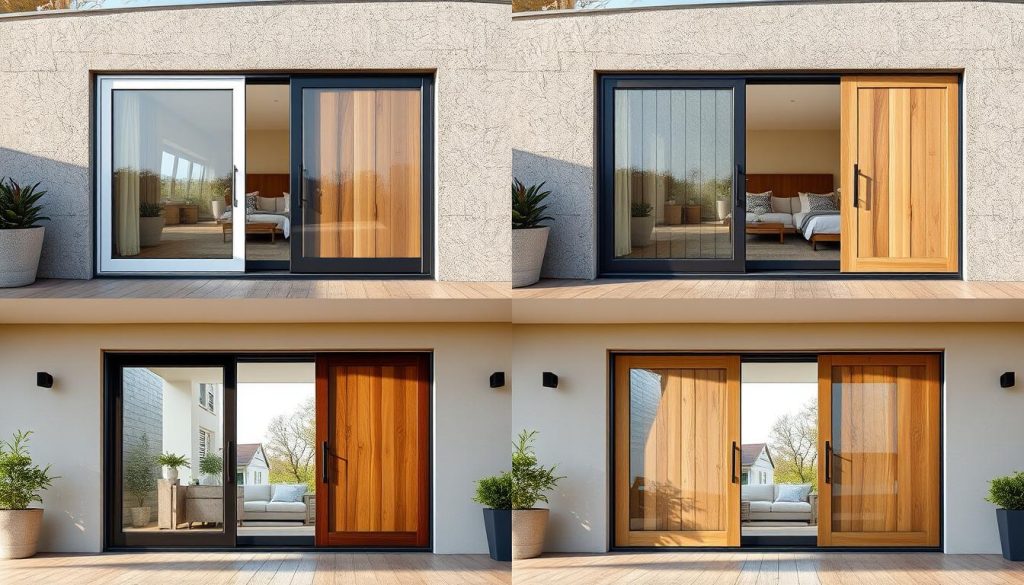
While structural durability forms the foundation of sliding door performance, aesthetic durability—how well doors maintain their appearance over time—significantly impacts homeowner satisfaction. Both aluminium and wooden sliding doors undergo appearance changes, but at dramatically different rates and requiring different interventions.
Aluminium Appearance Longevity
Modern aluminium sliding door frames feature powder-coated finishes available in numerous colors and textures. These finishes bond molecularly with the aluminium substrate, creating exceptionally durable surfaces that resist chipping, scratching, and fading far better than traditional paint systems.
Quality powder coatings maintain their appearance for 15-20+ years before potentially showing signs of fading in harsh environments. When appearance refreshing eventually becomes desirable, doors can be recoated without removing them from the building—a relatively straightforward process compared to wooden door refinishing.
Wooden Appearance Changes
Wooden sliding doors offer undeniable natural beauty, but this aesthetic requires significant protection to maintain. Without regular maintenance, wooden doors begin showing appearance changes within months in Australian conditions—developing uneven coloration, surface checking, and potential greying.
Even with diligent maintenance, achieving consistent appearance over decades proves challenging. Each refinishing cycle slightly alters the door’s look, and achieving perfect color matching becomes increasingly difficult as original materials age and evolve.
Design Flexibility and Updates
Beyond maintenance of original appearance, consider how each material accommodates changing design preferences:
- Aluminium sliding doors can be recoated in different colors when design preferences change
- Wooden doors can be refinished in different stains but with more labor-intensive processes
- Aluminium frames maintain consistent dimensions, ensuring accessories and hardware remain compatible
- Wooden frames may require hardware adjustments as dimensions shift over time
Design Consideration: While wooden sliding doors offer traditional warmth that many homeowners value, aluminium systems provide superior aesthetic stability with minimal intervention. For those seeking long-term appearance consistency with minimal maintenance, aluminium offers clear advantages.
Environmental Considerations in Durability
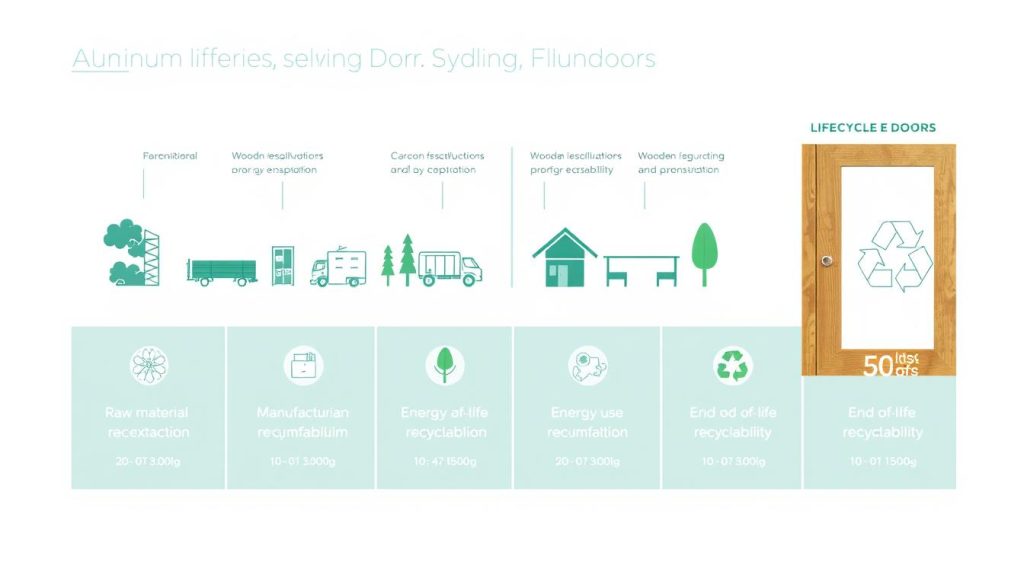
Environmental sustainability increasingly influences building material choices. When comparing the environmental aspects of aluminium and wooden sliding doors, durability itself becomes an environmental factor—longer-lasting products require fewer replacements and consume fewer resources over time.
Resource Efficiency
Aluminium sliding door frames utilize one of the most abundant metals in Earth’s crust. While initial production requires significant energy, modern aluminium increasingly incorporates recycled content, reducing environmental impact. The exceptional durability of aluminium means these resource investments deliver decades of service.
Wooden sliding doors use renewable resources when sourced from sustainable forestry operations. However, the shorter service life in demanding environments means more frequent replacement and thus higher cumulative wood consumption over decades of building use.
Maintenance Resources
The minimal maintenance requirements of aluminium sliding doors translate to reduced consumption of cleaning chemicals, finishes, and replacement components over their lifespan. This efficiency extends to reduced transportation impacts from maintenance-related service calls.
Wooden sliding doors require regular application of protective finishes, many containing volatile organic compounds (VOCs) and other chemicals. The cumulative environmental impact of these maintenance products, plus the energy used in application processes, adds significantly to the door’s lifetime footprint.
End-of-Life Considerations
Aluminium’s recyclability represents a major environmental advantage. At the end of their service life, aluminium sliding door frames can be fully recycled into new aluminium products with minimal quality loss. This closed-loop potential significantly reduces lifetime environmental impact.
Wooden sliding doors offer biodegradability advantages if untreated. However, most installed doors contain preservatives, finishes, and hardware that complicate disposal. While wood components may be downcycled into particleboard or similar products, complete recycling proves more challenging.
Durability as Sustainability
The relationship between durability and environmental impact creates important considerations:
- Longer-lasting products reduce manufacturing and disposal impacts through fewer replacement cycles
- Maintaining consistent performance reduces energy waste from poorly functioning doors
- Materials that maintain structural integrity longer keep more resources in active use
- Reduced maintenance requirements lower the lifetime chemical and resource consumption
“True sustainability extends beyond raw material selection to consider how long products remain functional. A door that lasts three decades creates significantly less environmental impact than three doors lasting a decade each, even if the longer-lasting option uses less renewable materials.”
Frequently Asked Questions
How long do aluminium sliding doors typically last compared to wooden ones?
Quality aluminium sliding doors typically last 30-40+ years in Australian conditions with minimal maintenance, while wooden sliding doors generally achieve 15-25 years with diligent maintenance. In coastal or tropical environments, this gap widens further, with wooden doors often requiring replacement within 10-15 years if maintenance isn’t perfect. The exceptional durability of aluminium stems from its inherent resistance to corrosion, UV damage, and dimensional stability regardless of climate conditions.
Do aluminium sliding door frames require special maintenance in coastal areas?
Aluminium sliding door frames in coastal areas benefit from slightly more frequent cleaning—typically every 3-4 months rather than twice yearly—to remove salt deposits before they can affect finishes. Quality marine-grade aluminium with appropriate powder coating requires no additional treatments or special products. Simply wash with mild soap and fresh water, rinse thoroughly, and ensure tracks remain clean. This minimal maintenance regimen maintains both appearance and function even in aggressive salt-air environments where wooden doors would require much more intensive care.
Can wooden sliding doors achieve the same durability as aluminium with proper care?
Even with meticulous maintenance, wooden sliding doors typically cannot match the durability of aluminium in challenging Australian environments. The organic nature of wood makes it inherently vulnerable to moisture, UV radiation, and biological degradation. While premium hardwoods with perfect maintenance can achieve impressive longevity, they still require significantly more care and typically show more operational issues over time. The practical reality is that few homeowners maintain the rigorous schedule required for optimal wooden door performance, making the durability gap even wider in real-world applications.
How do thermal breaks in aluminium sliding doors affect durability?
Thermal breaks in aluminium sliding doors significantly enhance durability by reducing temperature transfer between interior and exterior surfaces. This reduction minimizes condensation formation, which can damage surrounding building materials and finishes over time. By maintaining more consistent temperatures across the door system, thermal breaks also reduce thermal expansion stress on components and seals. Modern polyamide thermal break materials maintain their performance for decades without degradation, contributing to the overall durability advantage of quality aluminium systems while simultaneously improving energy efficiency.
Making Your Sliding Door Material Decision
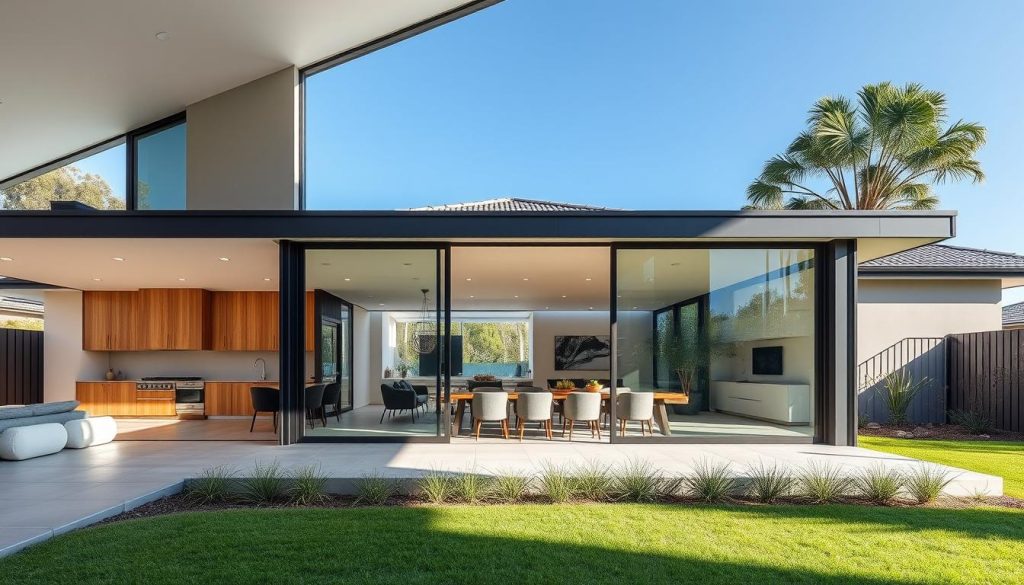
When comparing the durability of aluminium sliding doors with wooden sliding doors for Australian homes, the evidence consistently favors aluminium for long-term performance, reduced maintenance requirements, and overall value. While wooden doors offer undeniable aesthetic appeal and traditional charm, their durability limitations present significant practical challenges in Australia’s demanding climate conditions.
Aluminium sliding door frames provide exceptional resistance to the environmental factors that most severely impact door longevity—moisture, UV radiation, temperature fluctuations, and in coastal areas, salt exposure. This resistance translates to decades of reliable service with minimal maintenance requirements, making aluminium the pragmatic choice for homeowners seeking long-term performance.
For those drawn to wood’s natural warmth, consider that modern aluminium systems offer increasingly sophisticated finishes, including realistic wood-grain appearances that combine aesthetic appeal with aluminium’s superior durability. This compromise delivers the best of both worlds—the look of timber with the longevity of metal.
Ready to Explore Durable Sliding Door Options?
Discover our range of premium aluminium sliding doors designed specifically for Australian conditions.